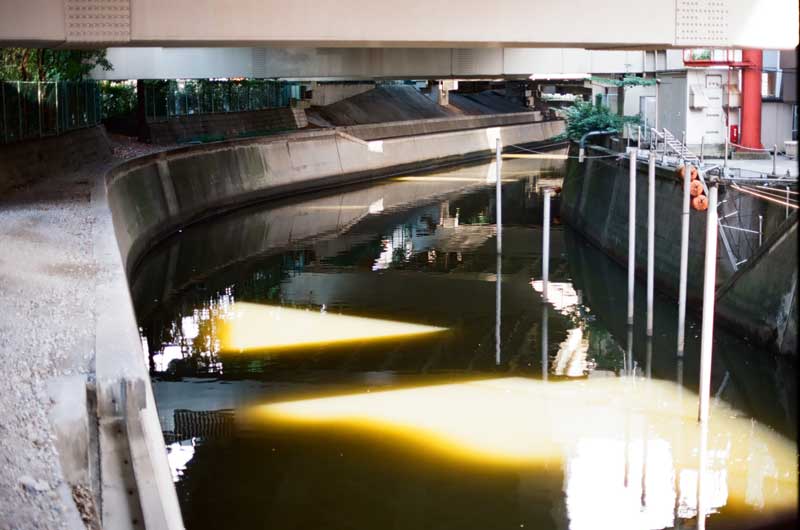
歩道の電力会社のボックスを隠している花の絵はすてきです。
What a gorgeous sidewalk flower.

首都高速道路の下の古川に何が住んでいるでしょうか。
Is there anything alive in this river? Cutting through Shiba in Minato-ku, it’s covered by the Shuto freeway and cut off from the street with a chain link fence. What a color!

東京湾のあたりは50年前に、高速道路と公園のようなインフラをたくさん作りました。全く使われていない不毛の空間ときれいな場所が同時に存在しています。雑草と偶然にできた緑の空間が生き残ります。
I often show images of the long cherry tree path that leads from Tatsumi’s subway to the municipal swimming pool. The 10 minute walk mixes all that’s both beautiful and dirty about 1960s infrastructure projects. There’s the amazing public sports facility, a now mature park with tall trees bordering the elevated freeway, and an odd mix of new construction, prior buildings, and informal green spaces that benefit from a lack of attention.



東京には、どこにも醜いエアコンがあります。シールで、かっこい飾りになりました。
To walk through Tokyo is to see air conditioners strapped onto buildings and littering the sidewalk. I like how someone used a simple grid of stickers to transform these two units into something special. This is a rare Tokyo Green Space post with zero plants or living organisms.

自転車で日本語の学校に行く途中で、山手道路沿いにいつもこの階段を見ます。坂を登って、林と神社を訊ねたい。代々木八幡の神社に行ったことがありますか。
I bike to school on Yamate Dori, one of Tokyo’s modern ring roads. It’s currently under construction and rather ugly: a freeway underground, a 6 lane road on the surface, sidewalks torn up, new and mostly undistinguishable apartment buildings. On this ride from Nakano to Shibuya, one of the highlights is glimpsing the stairs leading up to this tree-filled shrine. I stopped and found out that it is Yoyogi-Hachiman shrine. I haven’t made it up the stairs yet, but it beckons as an inviting escape from the more functional, profane city racing by it.

どうして六本木ヒルズの入り口は死んでいるのだろう?
Why is the entrance to Roppongi Hills so ugly and uninviting?
Every time I walk from the subway into Roppongi Hills I am shocked at the extremely ugly first view of this mega-complex. In addition to the elevated freeway, pedestrians are greeted by this horrendous, wide, astroturf-covered dead space in front of Roppongi Hills North Tower.
How could this make people want to enter Banana Republic? And what does this say about Mori Building’s vision for integrating their properties into their neighborhoods and communities? I feel that this forgotten and dirty space implies that the real landscape only begins at the podium level and that the North Tower is not of equal status to the rest of the complex, despite being in the front. It’s as if they imagine that their important customers enter the complex only by car.
This lack of respect for pedestrians, neighbors, and context is completely unnecessary. The smallest gesture would improve this space and make it more inviting and alive. If Mori Building reads this post, I hope they will consider improving this entryway to their otherwise well landscaped property. If anything, improving the entrance might also provide an opportunity to consider how to extend their landscape ideas further out into the neighborhood, creating connections with other shops and residents, and building a larger and healthier eco-system that would benefit Mori and their neighborhood.
Last night I attended the last Pecha Kucha Tokyo of the zeros decade, one block west of Roppongi Hills, and remembered that I had taken this photo weeks ago. Each time I am shocked as if for the first time. Outside of the expensive office towers and glittering malls, I wonder how such an ugly neighborhood can be attractive to multinational companies and foreign ex-pats.